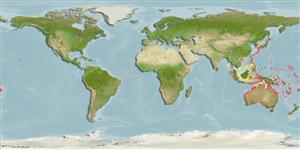Environment: milieu / climate zone / depth range / distribution range
Οικολογία
Θαλασσινό(ά) Υφαλόφιλο(α); εύρος βάθους 3 - 30 m (Ref. 86942), usually 3 - 4 m (Ref. 90102). Tropical
Western Pacific: Australia (known only from Rottnest Island and Shark Bay in Western Australia and One Tree Islands, in the Capricorn Group of the southern Great Barrier Reef). Recently reported from the Chesterfield Islands (Ref. 13236).
Μέγεθος / Βάρος / Age
Maturity: Lm ? range ? - ? cm
Max length : 5.0 cm TL αρσενικό/απροσδιόριστο; (Ref. 2334)
Ραχιαίες άκανθες (συνολικά) : 12; Μαλακές ραχιαίες ακτίνες (συνολικά) : 9; Εδρικές άκανθες: 2; Μαλακές εδρικές ακτίνες: 8. Body scales form expanded spinous points; each scale forms a blade-like ridge (Ref. 39602).
Occurs in rocky reefs and soft-bottom trawling grounds. Also found in sand and rubble bottoms, usually near reefs in 3-4 m (Ref 90102). Minimum depth from Ref. 090102.
Life cycle and mating behavior
Maturities | Αναπαραγωγή | Spawnings | Egg(s) | Fecundities | Προνύμφες
Randall, J.E., G.R. Allen and R.C. Steene, 1990. Fishes of the Great Barrier Reef and Coral Sea. University of Hawaii Press, Honolulu, Hawaii. 506 p. (Ref. 2334)
IUCN Red List Status (Ref. 130435)
Threat to humans
Harmless
Human uses
Εργαλεία
Special reports
Download XML
Διαδικτυακές πηγές
Estimates based on models
Preferred temperature (Ref.
123201): 15.5 - 29.3, mean 27.4 °C (based on 1659 cells).
Phylogenetic diversity index (Ref.
82804): PD
50 = 1.0000 [Uniqueness, from 0.5 = low to 2.0 = high].
Bayesian length-weight: a=0.01995 (0.00906 - 0.04395), b=3.01 (2.83 - 3.19), in cm total length, based on all LWR estimates for this body shape (Ref.
93245).
Τροφικό Επίπεδο (Ref.
69278): 3.2 ±0.3 se; based on size and trophs of closest relatives
Fishing Vulnerability (Ref.
59153): Low vulnerability (10 of 100).
